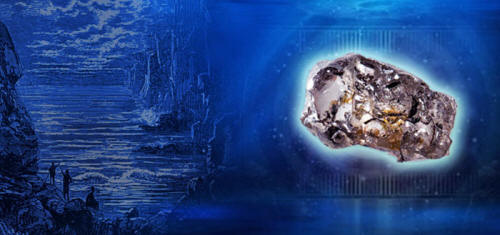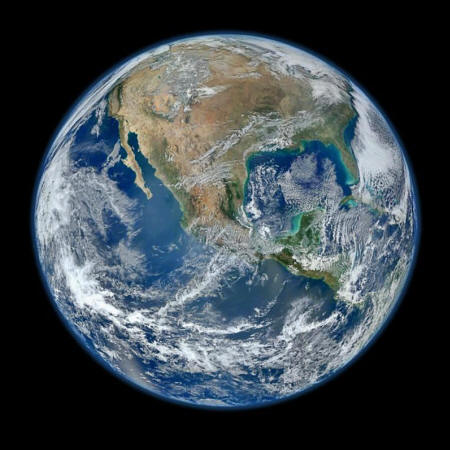|

by Richard Ingham
March 12, 2014
from
UKNewsYahoo Website
Recovered through
WayBackMacine Website

Earlier this year it was
reported that vast oceans of water could be hiding
under the earth’s mantle.
Water, necessity of
life. We look all over the earth, and even reach
into space in our search for water on other
planets and satellites.
Now scientists are suggesting that vast amounts
of water resources may be hidden right here,
within the earth’s mantle.
Nature World News
reported about it.
In 2013 scientists discovered a pocket of water
1.5 miles below the earth’s surface in Canada.
It was reportedly
1.5 billion years old.
Now this theory has more
support as scientists have discovered a rare diamond
which hints at a great "wet zone" far down within
the Earth that might hold as much water as all the
world’s oceans put together.

This NASA image
released on January 26, 2012
shows A 'Blue Marble'
image of the Earth
taken from the VIIRS
instrument aboard
NASA's
Earth-observing satellite
Suomi NPP
AFP/NASA/AFP/File -
Middle Earth Revelation?
Scientists say Gaia Contains
Giant, Secret Reservoir of
Water
One hundred and fifty years ago, in Journey to the Centre of the
Earth, French science-fiction forerunner Jules Verne pictured a vast
sea that lay deep under our planet's surface.
Today, that strange and haunting image has found an unexpected echo
in a scientific paper. That particular zone in the Earth, the
transition zone, might have as much water as all the world's oceans
put together.
Writing in the journal Nature, scientists said they had found an
elusive mineral pointing to the existence of a vast reservoir deep
in Earth's mantle, 400 to 600 kilometers beneath our feet.
It may hold as much water as all the planet's oceans combined, they
believe.
The evidence comes from a water-loving mineral called
ringwoodite
that came from the so-called transition zone sandwiched
between the upper and lower layers of Earth's mantle, they said.

"It was a bit of a
piece of luck":
Graham Pearson with
the first terrestrial sample of ringwoodite ever found.
Photo: Richard
Siemens/University of Alberta
Analysis shows a whopping 1.5 per cent of the rock comprises
molecules of water.
The find backs once-contested theories that the transition zone, or
at least significant parts of it, is water-rich, the investigators
said.
"This sample really provides
extremely strong confirmation that there are local wet spots
deep in the Earth in this area," said Graham Pearson of Canada's
University of Alberta, who led the research.
"That particular zone in the Earth, the transition zone, might
have as much water as all the world's oceans put together."
Ringwoodite is named after Australian
geologist Ted Ringwood, who theorized that a special mineral
was bound to be created in the transition zone because of the
ultra-high pressures and temperatures there.
A piece of this mineral has been a long-sought goal. It would
resolve a long-running debate about whether the poorly-understood
transition zone is bone-dry or water-rich.
But until now, ringwoodite has only ever been found in meteorites.
Geologists had simply been unable to delve deep enough to find any
sample on Earth.
Good fortune, though, changed all this.
In 2008, amateur gem-hunters digging in shallow river gravel in the
Juina area of Mato Grosso, Brazil,
came across a tiny, grubby stone called a brown diamond.
Measuring just three millimeters across and commercially worthless,
the stone was acquired by the scientists when they were on a quest
for other minerals.
But the accidental acquisition turned out to be a bonanza.

Ringwoodite:
diamond from Earth’s
’wet zone’
Photo: Richard
Siemens/University of Alberta
In its interior, they found a microscopic trace of
ringwoodite - the very first
terrestrial evidence of the ultra-rare rock.
"It's so small, this inclusion, it's
extremely difficult to find, never mind work on," Pearson said,
paying tribute to the diligent work of grad student John
McNeill.
"It was a bit of a piece of luck, this discovery, as are many
scientific discoveries."
The team theorize the brown diamond
rocketed to the surface during a volcanic eruption, hitchhiking in a
stream of kimberlite, the deepest of all volcanic rocks.
Years of analysis, using spectroscopy and X-ray diffraction, were
needed in specialized labs to confirm the find officially as
ringwoodite. Scientists have debated for decades about whether the
transition zone has water, and if so, how much there might be.
None, though, has embraced Verne's fancy of a subterranean sea with
a rocky coastline dotted with forests of giant mushrooms and
petrified trees.
Hans Keppler, a geologist at the University of Bayreuth in
Germany, cautioned against extrapolating the size of the
subterranean water find from a single sample of ringwoodite.
He also said the water was likely to be locked up in specific rocks,
in a molecular form called hydroxyl.
"In some ways it is an ocean in
Earth's interior, as visualized by Jules Verne… although not in
the form of liquid water," Keppler said in a commentary also
published by Nature.
The implications of the discovery are
profound, Graham Pearson suggested.
If water exists in huge volumes beneath Earth's crust, it is bound
to have a big impact on the mechanics of volcanoes and the movement
of tectonic plates.
"One of the reasons the Earth is
such a dynamic planet is the presence of some water in its
interior. Water changes everything about the way a planet
works," said Pearson.
Oceans Worth of Water
...Could
be Trapped Beneath the Earth's Mantle
by James A. Foley
January 27, 2014
from
NatureWorldNews Website
Large amounts of ocean water could be transported through deep-sea
fault zones in volumes much greater than previously believed,
according to new research from the University of Liverpool, which
focused on the
subduction zone that led to the
2011 Tohoku earthquake in Japan.
The research supports the theory that there could be vast amounts of
water buried deep beneath the Earth's mantle.
Understanding how much ocean water is delivered to the mantle is
important because it helps explain how the mantle bows and arches
and how it melts, which helps solidify theories on the origins of
plate tectonics and how the continental crust was formed.
Water is carried to the mantle via deep sea fault zones which breech
the oceanic plate as it bends into the subduction zone, which is
where one tectonic plate meets another and is forced beneath it. The
largest earthquakes occur along subduction zones, such as the March
11, 2011 Tohoku earthquake, which registered at 9.0 on the Richter
scale and triggered a devastating tsunami.
Based on their research, University of Liverpool seismologists
suggest that over the age of the Earth, the Japan subduction zone
alone could transport as much as three and a half times the water
contained in all of Earth's oceans to the mantle.
Some of this water gets cycled back out
of the mantle, but some gets trapped deep within it.
"It has been known for a long time
that subducting plates carry oceanic water to the mantle," said
Tom Garth, a PhD student in the Earthquake Seismology research
group at Liverpool.
"We found that fault zones that form in the deep oceanic trench
offshore Northern Japan persist to depths of up to 150
kilometers," Garth said.
"These hydrated fault zones can carry large amounts of water,
suggesting that subduction zones carry much more water from the
ocean down to the mantle than has previously been suggested,"
Garth said.
"This supports the theory that there
are large amounts of water stored deep in the Earth."

Tom Garth and his colleagues'
research (Order
of Magnitude Increase in Subducted H²O due to Hydrated Normal Faults
within the Wadati-Benioff Zone) is published in the
journal Geology.
Scientists Find...
1.5-Billion-Year-Old Pockets of Water
...in
Canadian Mine
May 16, 2013
from
Sci-News Website
Researchers from Canada and the United Kingdom led by Prof Chris
Ballentine from the University of Manchester have discovered
ancient water pockets that have been isolated deep underground for
more than a billion years.

Billion year old
sparkling water
(J. Moran)
The scientists analyzed water pouring out of boreholes from a mine
1.5 miles (2.4 km) beneath Ontario, Canada.
According to their study published in the journal Nature, this water
could be some of the oldest on Earth and may even contain life. The
similarity between the rocks that trapped it and those on Mars
raises the hope that comparable life-sustaining water could lie
buried beneath the Red planet's surface.
The team found that the water is rich in dissolved gases like
hydrogen, methane and isotopes of noble gases such as helium, neon,
argon and xenon. Indeed, there is as much hydrogen in the water as
around hydrothermal vents in the deep ocean, many of which teem with
microscopic life.
The hydrogen and methane come from the
interaction between the rock and water, as well as natural
radioactive elements in the rock reacting with the water. These
gases could provide energy for microbes that may not have been
exposed to the sun for billions of years.
The crystalline rocks surrounding the water are thought to be around
2.7 billion years old. But no-one thought the water could be the
same age, until now.
Using ground-breaking techniques, the
researchers show that the fluid is at least 1.5 billion years old,
but could be significantly older.
"We've found an interconnected fluid
system in the deep Canadian crystalline basement that is
billions of years old, and capable of supporting life.
Our finding is of huge interest to
researchers who want to understand how microbes evolve in
isolation, and is central to the whole question of the origin of
life, the sustainability of life, and life in extreme
environments and on other planets," Prof Ballentine said.
Before this discovery, the only water of
this age was found trapped in tiny bubbles in rock and is incapable
of supporting life.
But the water found in the Canadian mine
pours from the rock at a rate of nearly two liters per minute. It
has similar characteristics to far younger water flowing from a mine
1.7 miles (2.8 km) below ground in South Africa that was previously
found to support microbes.
The researchers don't yet know if the underground system in Canada
sustains life.
"Our Canadian colleagues are trying
to find out if the water contains life right now. What we can be
sure of is that we have identified a way in which planets can
create and preserve an environment friendly to microbial life
for billions of years.
This is regardless of how
inhospitable the surface might be, opening up the possibility of
similar environments in the subsurface of Mars," explained first
author Dr Greg Holland of Lancaster University.
Bibliographic information:
|







